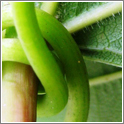Climbing plants and tactile-based grasping devices

Over the last several decades the research on robotic manipulators has focused mainly on designs that resemble the human arm. The designs are based on discrete rigid links serially connected by joints. If we examine the manipulators available in nature, we will see a plethora of other possibilities. Animals such as snakes, elephants, and octopuses can produce motions from their appendages or bodies that allow the effective manipulation of objects, even though they are quite different in structure compared to the human arm. Moving from the animal to the vegetal world, we can also find some example of grasping structures.
Climbing plants are capable to grasp objects by extending themselves and then use the objects as support by coiling around them. The goal is to achieve maximum vertical height for rich sun exposure while avoiding the energy expenditure of developing a supporting trunk. Unlike the examples in the animal kingdom, climbing plants do not rely on vision to attain the support, but drive their tendrils (the organs specialized in grasping) using only the contact sense.
Project overview
The study explores how tendrils can be imitated and what the advantages in imitating them are. Robotic grasping is a complex task and poses some very intricate problems. One of the main difficulties is to be able to generalise to variations of object position, orientation and shape. For this reason, most of the robotic grasping known assumes a grasped object and all information needed for the grasping to occur. Alternatively, they rely on vision to obtain relevant information about the objects. The sensory and actuation system of plants may be less dynamic than our human senses and muscles but still have the advantage of greater autonomy.
The biomimetic of the tendril may be extremely valuable for use in autonomous robots, such as controlling the length of momentum exchange tether or electrodynamics tethers, grasping debris to facilitate their removal, terminal docking, space refuelling and self-assembly and, in general, all those missions where grasping or controlling a tether length could offer a solution to a space engineering problem.
References
- Darwin C. (1865). On The Movements and Habits of Climbing Plants. London: John Murray.
- Engelberth J., Wanner G., Groth B. and Weiler E.W. (1995). Functional anatomy of the mechanoreceptor cells in tendrils of Bryonica dioica Jacq. Planta 196: 539-550
- Isnard S., Silk W.K. (2009) Moving with climbing plants from Charles Darwin's time into the 21st century. American Journal of Botany 96: 1205-1221.
- Jaffe M.J., Galston A.W. (1968). The physiology of tendrils. Annual Review of Plant Physiology 19: 417-434.